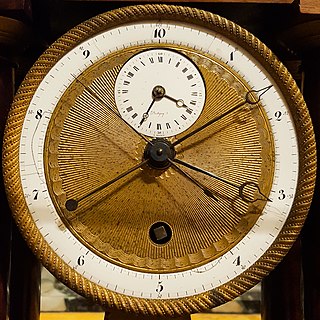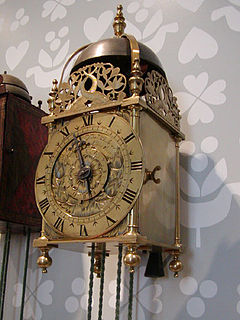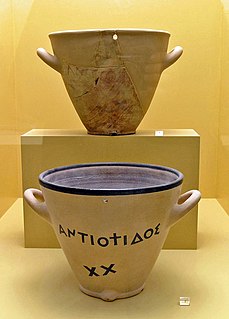 W
WThe Catalan time system is the traditional manner in which to tell time in Catalan, and it is exclusive to this language. Telling the time through this system works by dividing it in fractions of a quarter and half a quarter of an hour. Hour-fractions refer to the starting hour, taking into account that when a clock reaches a whole hour it actually indicates its end.
 W
WA clock is a device used to measure, keep, and indicate time. The clock is one of the oldest human inventions, meeting the need to measure intervals of time shorter than the natural units: the day, the lunar month, and the year. Devices operating on several physical processes have been used over the millennia.
 W
WDecimal time is the representation of the time of day using units which are decimally related. This term is often used specifically to refer to the time system used in France for a few years beginning in 1792 during the French Revolution, which divided the day into 10 decimal hours, each decimal hour into 100 decimal minutes and each decimal minute into 100 decimal seconds, as opposed to the more familiar UTC time standard, which divides the day into 24 hours, each hour into 60 minutes and each minute into 60 seconds.
 W
WHexadecimal time is the representation of the time of day as a hexadecimal number in the interval [0,1).
 W
WThe six-hour clock, also called the Roman or the Italian system, was a system of date and time notation in Italy which preceded the modern 24-hour clock. In this system, the day starts at the evening Ave Maria at the end of twilight, approximately half an hour after sunset, and the following 24 hours are divided into four cycles of six hours each.
 W
WA lantern clock is a type of antique weight-driven wall clock, shaped like a lantern. They were the first type of clock widely used in private homes. They probably originated before 1500 but only became common after 1600; in Britain around 1620. They became obsolete in the 19th century.
 W
WNew Earth Time is an alternative naming system for measuring the time of day. In NET the day is split into 360 NET degrees, each NET degree is split into 60 NET minutes and each NET minute is split into 60 NET seconds. One NET degree is therefore equivalent to four standard minutes, and one standard hour is equivalent to 15 NET degrees.
 W
WA pitch clock is used in college baseball and Minor League Baseball to limit the amount of time a pitcher uses before he throws the ball to the hitter. This is one measure that has accelerated the pace of play.
 W
WIn Roman timekeeping, a day was divided into periods according to the available technology. Initially the day was divided into two parts: the ante meridiem and the post meridiem, before noon and afternoon, respectively. With the advent of the sundial circa 263 BC, the period from sunrise to sunset was divided into 12 hours.
 W
WA ship's bell is a bell on a ship that is used for the indication of time as well as other traditional functions. The bell itself is usually made of brass or bronze, and normally has the ship's name engraved or cast on it.
 W
WA shot clock is a countdown timer used in basketball that provides a set amount of time that a team may possess the ball before attempting to score a field goal. It is distinct from the game clock, which displays the time remaining in the period of play. It may be colloquially known as the 24-second clock, particularly in the NBA and other leagues where that is the duration of the shot clock. If the shot clock reaches zero before the team attempts a field goal, the team has committed a shot clock violation, which is penalized with a loss of possession.
 W
WA shot timer is a shot activated timer used in shooting sports, which starts the competitor by an audible signal and also records the competitor's time electronically by detecting the sound of each shot together with the time from the start signal. When the competitor is finished the timer will show the time from the start signal until the last shot. The time is usually recorded to hundredths of a second (centisecond), which is required by competitions in the International Practical Shooting Confederation.
 W
WSwatch Internet Time is a decimal time concept introduced in 1998 by the Swatch corporation as part of their marketing campaign for their line of "Beat" watches.
 W
WUnix time is a system for describing a point in time. It is the number of seconds that have elapsed since the Unix epoch, minus leap seconds; the Unix epoch is 00:00:00 UTC on 1 January 1970 ; leap seconds are ignored, with a leap second having the same Unix time as the second before it, and every day is treated as if it contains exactly 86400 seconds. Due to this treatment Unix time is not a true representation of UTC.
 W
WWatchkeeping or watchstanding is the assignment of sailors to specific roles on a ship to operate it continuously. These assignments, also known as at sea watches are constantly active as they are considered essential to the safe operation of the vessel, and also allow the ship to respond to emergencies and other situations quickly. These watches are divided into work periods to ensure that the roles are always occupied at all times, while those members of the crew who are assigned to a work during a watch are known as watch keepers.
 W
WA water clock or clepsydra is any timepiece by which time is measured by the regulated flow of liquid into or out from a vessel, and where the amount is then measured.